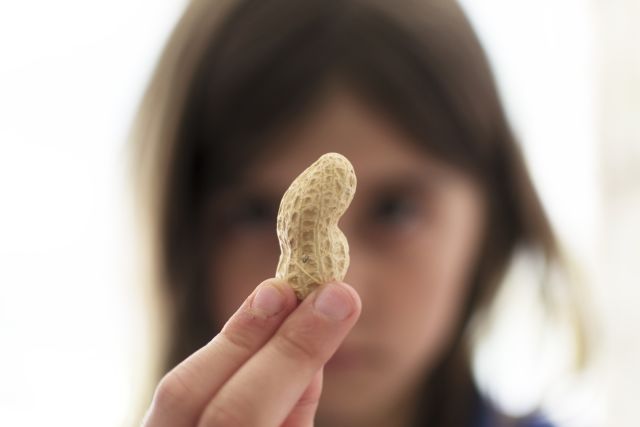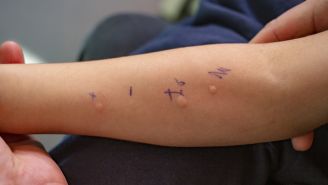Updated on October 7, 2022.
Whether you’ve read the tragic news stories, know someone who’s had a serious reaction, or experienced a close call yourself, you’re likely aware that a peanut allergy is no joke. It occurs when your immune system overreacts to peanuts, and in a worst-case scenario, it can kill you.
"A peanut allergy has been recognized as one of the most serious food allergies due to the potential severity of allergic reaction," says Marvin Rios, MD, a pediatrician affiliated with Kendall Regional Medical Center in Tamiami, Florida. "It's a big problem all over the world."
Thought to affect about 2 percent of children and 1 percent of adults in the United States, peanut allergies are becoming more common, studies suggest. With that in mind, here’s what you should know about this growing problem.
The basics of peanut allergies
First thing’s first: Peanuts technically aren’t nuts. They belong to the legume family, along with beans and lentils. And unlike tree nuts, such as almonds and pistachios, they grow in the ground. Somewhat strangely, people with peanut allergies aren’t typically allergic to other legumes, but they do have a higher chance of reacting to tree nuts.
When someone has a peanut allergy, they react to eating peanuts or food made with peanuts. Cross contact can also be a problem. For example, if a peanut-free food is produced on the same factory machine as a food including peanuts, it may trigger a response. Skin contact with peanuts can mean trouble for some people, too, as can inhaling peanut dust.
Peanut allergies usually start during childhood and often last a lifetime, though about 20 percent of kids do grow out of them, according to the American College of Allergy, Asthma, and Immunology. It’s uncommon for adults to develop a new allergy to peanuts. To know: A peanut allergy is different from an intolerance, which can be uncomfortable, but is not life-threatening and is generally limited to the gastrointestinal tract.
Peanut allergy symptoms can vary depending on the person and may change in an individual over time. In other words, you can develop hives after eating a peanut one day, but have serious trouble breathing the next. Whatever your reaction, symptoms often come on fast, and can include:
- Hives, redness, or swelling of skin
- Swelling or itching in or around the mouth
- Itchy, swollen, red, or watery eyes
- Coughing, sneezing, and runny nose
- Itching, tingling, tightening, or swelling in your throat; hoarse voice
- Wheezing or problems breathing
- Dizziness or lightheadedness
- Digestive issues like indigestion, abdominal cramps, nausea, vomiting, or diarrhea
- Weak or rapid pulse
Some people with peanut allergies may experience anaphylactic shock, a life-threatening response involving the entire body. Severe dizziness, swelling of the tongue, and breathing problems are common signs, as are blue lips, pale skin, a dip in blood pressure, and fainting. Anaphylaxis requires an immediate injection of epinephrine, followed by an emergency room visit.
"You have to use the EpiPen and call 911," says Dr. Rios. "That needs to be done right away for a patient with anaphylactic reaction."
If you think you have a peanut allergy, it’s important to get an accurate diagnosis from a certified allergist. Keep a food diary until your appointment, noting unusual responses to anything you eat. At the office, you may receive a blood test—which looks for high levels of an antibody specific to peanuts—or a skin test, where the allergen is applied to your skin in search of a reaction. Your allergist may also try an oral food challenge, during which you’re given small amounts of peanut to test for a response.
Introducing peanuts to kids
In years past, giving peanuts and peanut products to babies and young children was discouraged, as it was believed to raise their odds of developing an allergy. But more recently, experts have come to understand that introducing peanut-based foods with other solid foods is typically harmless and likely protective.
"The American Academy of Pediatrics (AAP) recommends now the introduction of peanut in tiny amounts after 4, 5, or 6 months," says Rios.
The official AAP guidelines are:
- Infants with severe eczema or an egg allergy are considered high risk, and it’s strongly advised they be tested for a peanut allergy prior to introducing the food. Between 4 and 6 months old, they may begin eating specified amounts of "peanut-enriched" foods with a go-ahead from a healthcare provider (HCP). You may want your HCP present for the initial taste.
- Infants with mild to moderate eczema can start on foods with peanuts around 6 months. Parents and guardians should be able to introduce the items at home.
- Infants with no eczema or existing food allergy are likely safe from developing a peanut allergy. They should be introduced to peanut products depending on parental preference.
Speak with an HCP about the best time to introduce peanut foods to your baby. Do not feed whole peanuts or chunky peanut butter to babies, since they may choke. Instead, try peanut butter-flavored snacks or diluting smooth peanut butter with other foods, like banana puree.
Foods to avoid
If you have a known peanut allergy, the only way to prevent a reaction is to avoid peanuts entirely. That means steering clear of peanuts and food that may be made with peanuts. These include, but are not limited to:
- Peanut butter
- Nut mixes and beer nuts
- Candy, candy bars, marzipan, and nougat
- Baked goods like cookies and cakes
- Peanut flour
- Ice cream and other frozen desserts
- Breakfast cereals and granola
- Granola bars and energy bars
- Grain breads
- Dressings, marinades, glazes, and sauces
- Vegetarian or meat substitute products
- Thai, Vietnamese, Indonesian, Chinese, Indian, African, and Mexican cuisine
Even if a food doesn’t seem like it should contain peanuts, don’t assume that it’s peanut-free. Make sure to read all ingredient lists on packaged items; since peanuts are one of the top nine food allergens, U.S. manufacturers are legally required to highlight their presence. Look, too, for notices that a product "may contain peanuts" or is made in a factory that also handles nuts.
While peanut butter is off limits, there’s a good chance you may be able to tolerate other nut and seed butters, such as almond, cashew, or sunflower seed butter. People with peanut allergies can also usually consume the refined peanut oil used in many processed foods. Unrefined peanut oil, often called "gourmet" or "cold-pressed" peanut oil, may present problems, however. To be safe, speak with an allergist before consuming nut butters, peanut oil, or arachis oil, which is sometimes used as an alternate name for peanut oil.
Heading out to eat? Whether you go to a fancy restaurant or a local ice cream parlor, always ask your server or host if your food contains peanuts, and make sure they check with the chef. When in doubt, pick another food.
Planning for an attack
No matter how diligent you are about avoiding peanuts, there’s a chance you will accidentally ingest them. To protect yourself, always keep an epinephrine autoinjector (EpiPen, Auvi-Q, Twinject, Adrenaclick, etc.) handy. Know how and when to use it, and double-check that the medicine is within its expiration date. Make sure your friends, family, and coworkers understand what could happen if you eat peanuts, and that they know what to do in an emergency.
And if it’s your child with the allergy? "In children we have to make the plan for both school and at home," says Rios. "At home, we train the parents how to use the EpiPen, how to recognize symptoms, what to do, and what not to do."
At school, parents should alert all appropriate school staff of the allergy, including teachers, coaches, cafeteria workers, and the school nurse. At the beginning of the school year, create a written plan for treatment, like FARE's Food Allergy & Anaphylaxis Emergency Care Plan. Make sure an epinephrine autoinjector is available at all times, and warn your child about the danger of sharing foods. Wearing a medical alert bracelet is a good idea for both kids and adults with peanut allergies.
Cures and treatments
Currently, there is no cure for a peanut allergy. However, scientists are studying ways of desensitizing people to the food allergen, or raising the amount of peanut needed to trigger an allergic response.
Oral immunotherapy (OIT) must be done under the close supervision of an allergist. It involves giving a patient a small amount of peanut powder, and as their body gets used to it, gradually increasing that dose over time.
In January 2020, the U.S. Food and Drug Administration (FDA) approved the first OIT drug, called Palforzia, for kids ages 4 through 17—though not without controversy. While the medication was effective at reducing reactions in trials, it also greatly raised the risk of anaphylaxis. To lower this risk, patients must take Palforzia in a certified healthcare setting, and are required to enroll in a safety program before they start using it. The FDA also cautions that anyone taking the newly approved drug should continue to avoid peanuts and carry injectable epinephrine all times.
Peanut patches are small, round patches that release peanut proteins into the body, helping to build up tolerance. They come in lower or higher doses and are applied daily over many months. Many patients in trials have experienced allergy symptoms while using the patch, but they’ve generally tended to be milder. Peanut patches are not currently FDA-approved.
Peanut allergy treatments are constantly in development, and these therapies aren’t the only ones being explored. But, bottom line: Until doctors come up with a permanent solution, steer clear of peanuts—and know what to do in an emergency.







